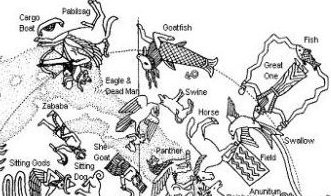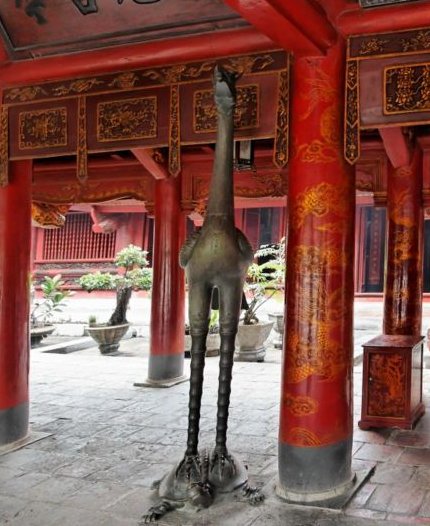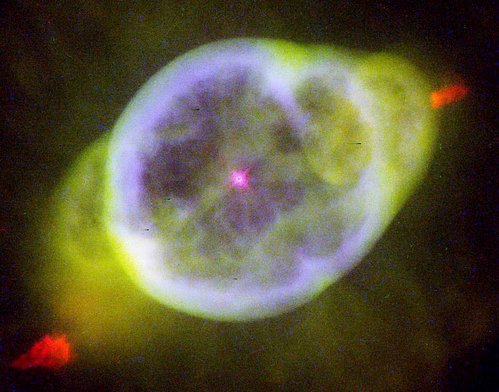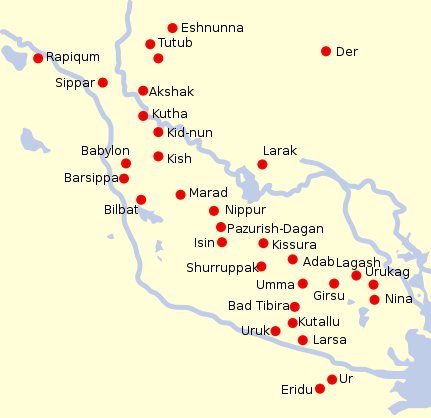Later in Manuscript E we can read how the Explorers in "July 10
- when the Sun rose at Regulus - went from Te Pou to
Hanga Takaure:
|
0 |
Nga Kope
Ririva Tutuu Vai |
A Te
Taanga |
|
1 |
Pu
Mahore |
A
Hau Maka O Hiva |
|
2 |
Poko Uri |
A
Hau Maka I [Sic!] Hiva |
|
3 |
Te
Manavai |
A Hau
Maka O Hiva |
|
4 |
Te Kioe
Uri |
|
5 |
Te
Piringa Aniva |
|
6 |
Te Pei |
|
7 |
Te Pou |
|
8 |
Hua Reva |
|
9 |
Akahanga |
|
10 |
Hatinga
Te Kohe |
|
11 |
Roto Iri
Are |
|
12 |
Tama He
Ika Kino He Ihu Roroa |
- |
|
13 |
One
Tea |
A Hau
Maka O Hiva |
|
14 |
Hanga
Takaure |
|
15 |
Poike |
... They took their provisions with them,
carrying them on their shoulders, went on, and reached Te Pou.
They made camp and slept in Te Pou on the tenth day of
the month of July ('Anakena'). [E:22]
Then they all got up, carried their
provisions on their shoulders, went straight ahead, and followed
the path of the dream soul of Hau Maka. They came to
Hua Reva and said, This is Hua Reva A Hau Maka!
They went on and reached Akahanga,
took a look at it and looked around. They said: This is it! and
gave the name Akahanga A Hau Maka.
They went on and came to Hatinga Te Kohe
and saw that in this place the kohe plant had been
broken. They all said, Here it is, the kohe plant, troop
of young men! This kohe plant had been broken by the feet of the
dream soul and therefore they gave the name Hatinga Te Kohe A
Hau Maka. They went on and came to Roto Iri Are.
Again they said, There it is, Roto Iri Are and named (the
place) Roto Iri Are A Hau Maka. They went on and reached Tama. They
looked around and said, This is Tama. They gave the name
Tama, an evil fish (he ika kino), a very long nose
(He ihu roroa). Again they went on and came to One Tea.
They saw it, looked around, and gave the name One Tea A Hau
Maka.
Then
they went on and came to Hanga Takaure. There they gave
the name Hanga Takaure A Hau Maka. They made camp and
rested at the Bay of Flies for a week (etahi pohitu).
On
the
eighteenth day of the month of July (Anakena) they went
on from Hanga Takaure. They climbed uphill, went on,
and reached Poike. When they arrived, they looked around
and named (the place) 'Poike A Hau Maka' ...
"July 18
was day 199 and "July 10 (191) was 8 days earlier. If the
Explorers had stayed for
a week at Hanga Takaure they ought to have arrived there
in "July 11 (192 = 199 - 7).

... From the year 755 (when Cancer had been
at July 11 according to the Mayas) to AD
1842 (my assumed baseline for the rongorongo
texts) there were around (1842 - 755) / 71 =
15 precessional days. This seems to point to
the time of the Bull, when in JANUARY 31 the
old year would end (terminate). 192 (JULY
11) - 31 = 161 (JUNE 10 )
...

...
Midsummer is the flowering season of the
oak, which is the tree of endurance and
triumph, and like the ash is said to 'court
the lightning flash'.

Its roots are believed
to extend as deep underground as its
branches rise in the air - Virgil mentions
this - which makes it emblematic of a god
whose law runs both in Heaven and in the
Underworld ... The month, which takes its
name from Juppiter the oak-god, begins on
June 10th and ends of July 7th. Midway
comes St. John's Day, June 24th, the day on
which the oak-king was sacrificially burned
alive. The Celtic year was divided into two
halves with the second half beginning in
July, apparently after a seven-day wake, or
funeral feast, in the oak-king's honour
...
I have
assumed the dates given
in Manuscript E for the Explorers were based on the time frame of Bharani. In
"July 10 (191) a new little Sun King (Regulus) rose heliacally -
a week after the old one had been terminated at
Bunda
(The Knot):
... The manner of his death can be
reconstructed from a variety of legends, folk-customs and other
religious survivals. At mid-summer, at the end of a half-year
reign, Hercules is made drunk with mead and led into the middle
of a circle of twelve stones arranged around an oak, in front of
which stands an altar-stone; the oak has been lopped until it is
T-shaped. He is bound to it with willow thongs in the 'five-fold
bond' which joins wrists, neck, and ankles together, beaten by
his comrades till he faints, then flayed, blinded, castrated,
impaled with a mistletoe stake, and finally hacked into joints
on the altar-stone. His blood is caught in a basin and used for
sprinkling the whole tribe to make them vigorous and fruitful.
The joints are roasted at twin fires of oak-loppings, kindled
with sacred fire preserved from a lightning-blasted oak or made
by twirling an alder- or cornel-wood fire-drill in an oak log.
The trunk is then uprooted and split into faggots which are
added to the flames. The twelve merry-men rush in a wild
figure-of-eight dance around the fires, singing ecstatically and
tearing at the flesh with their teeth. The bloody remains are
burnt in the fire, all except the genitals and the head. These
are put into an alder-wood boat and floated down the river to an
islet; though the head is sometimes cured with smoke and
preserved for oracular use. His tanist succeeds him and reigns
for the remainder of the year, when he is sacrificially killed
by a new Hercules ...
 |
 |
 |
 |
 |
 |
|
Ga3-19 (78) |
Ga3-20 |
Ga3-21 (→ 0h) |
Ga3-22 |
Ga3-23 |
Ga3-24 |
|
CLOSE TO THE SUN: |
|
The
Knot (Ukdah) |
Rishu A.-13 (Head of the Lion)
ψ Leonis (146.4),
RAS ELASET AUSTRALIS = ε Leonis
(146.6)
*105.0 = *146.4 - *41.4 |
VATHORZ PRIOR =
υ
Carinae
(147.9) |
|
Star-25 (Horse) /
ANA-HEU-HEU-PO-5 (Pillar where debates
were held)
ALPHARD (The Horse) =
α
Hydrae
(142.3),
ω
Leonis (142.6),
τ¹
Hydrae (142.7) |
Al Tarf-7 (The End)
ψ
Velorum (143.3),
ALTERF = λ Leonis,
τ²
Hydrae (143.4),
ξ
Leonis (143.5)
*102.0 = *143.4 - *41.4 |
A Hydrae (144.1)
VEGA (α Lyrae) |
UKDAH
(Knot) = ι Hydrae
(145.4), κ Hydrae (145.5),
SUBRA (Mane)= ο Leonis
(145.8)
*104.0 = *145.4 - *41.4 (= *288 - *184)
|
|
Aug 10 |
11 |
12 |
13 |
14 (*146) |
15 (227) |
|
°Aug 6 |
7 |
8 (220) |
9 |
10 |
11 (*143) |
|
'July 14 |
15 |
16 |
17 (*118 =
4 * 29½ |
18 |
19 (200) |
|
SIRIUS |
"July 1 |
2 |
3 (*104 = 2 * 52) |
4 (185) |
5 |
|
JUNE 7 (*78) |
8 |
9 |
10 (161) |
11 |
12 |
|
DAY 142 |
143 |
144 (= 12 * 12) |
145 = 290 / 2 |
146 |
147 |
|
CLOSE TO THE FULL MOON: |
|
BUNDA
(Foundation) / KAKKAB
NAMMAΧ (Star of Mighty Destiny) |
θ
Piscis Austrini (330.1),
λ
Oct.
(330.7) |
|
Al Sa'd al Su'ud-22 (Luckiest of the
Lucky) /
Emptiness-11 (Rat)
TSIN = 36 Capricorni
(325.2),
ALPHIRK (The Flock) =
β
Cephei
(325.7),
SADALSUD
=
β
Aquarii,
ξ
Gruis (325.9) |
no star listed (326) |
CASTRA = ε Capricorni (327.2),
BUNDA = ξ Aquarii
(327.5)
SIRIUS (α Canis Majoris)
|
Mahar sha hi-na Shahū-26 (Western One in
the Tail of the Goat)
NASHIRA =
γ
Capricorni
(328.0),
ν
Oct. (328.3), AZELFAFAGE
=
π¹
Cygni,
κ
Capricorni (328.7 |
Arkat sha hi-na Shahū-27 (Eastern One in
the Tail of the Goat)
ENIF (The Nose) =
ε
Pegasi, ERAKIS =
μ
Cephei
(329.2),
46 CAPRICORNI,
JIH (the Sun) = κ
Pegasi
(329.3),
ι
Piscis Austrini (329.4),
λ
Capricorni (329.6),
ν
Cephei (329.7),
DENEB ALGIEDI
=
δ
Capricorni
(329.8)
*288.0 = *329.4 - *41.4 |
|
Febr 9 (40) |
10 |
11 |
12 (408) |
13 (*329) |
All Hearts' Day |
|
°Febr 5 |
6 |
7 |
8 (*324) |
9 (40) |
10 |
|
'Jan 13 (378) |
14 |
15 (*300) |
16 |
17 |
18 (383) |
|
"Dec 30 |
31 (*285) |
"Jan 1 |
2 |
3 (368) |
4 |
|
DEC 7 |
8 |
9 |
10 |
11 (345) |
12 (*266) |
|
DAY 325 (→ 3-25) |
326 |
327 |
328 |
329 |
330 |

 |
|
JUNE
13 |
14
(*85) |
15 |
16 |
17
(168 = 24 * 7) |
18 |
19 |
 |
 |
 |
 |
 |
 |
 |
|
Ga4-1 |
Ga4-2 |
Ga4-3 |
Ga4-4 |
Ga4-5 |
Ga4-6 |
Ga4-7 (90) |
|
CLOSE TO
THE SUN: |
|
υ¹
Hydrae (148.4),
RAS ELASET BOREALIS (Northern Head of the Lion)
=
μ
Leonis
(148.7)
*107.0 = *148.4 - *41.4 |
TSEEN KE (Heaven's Record) =
φ
Velorum
(149.9) |
ν Leonis (150.1), π Leonis (150.6) |
υ² Hydrae (151.8) |
Al Jabhah-8 (Forehead) /
Maghā-10 (Bountiful) /
Sharru-14 (King)
10h (152.2)
AL JABHAH =
η
Leonis
(152.4),
REGULUS
(Little KIng) =
α
Leonis
(152.7)
*111.0 = *152.4 - *41.4 |
λ Hydrae (153.2) |
ADHAFERA = ζ Leonis,
TANIA BOREALIS (Northern Gazelle) = λ Ursae
Majoris,
SIMIRAM = ω Carinae
(154.7) |
|
Aug 16 |
17
(229) |
18 |
19 |
20
(*152) |
21 |
22 |
|
°Aug 12 |
13
(225) |
14 |
15 |
16
(*148) |
17 |
18 |
|
'July 20 (201) |
21 |
22 /
7 |
23 |
24
(*125) |
25 |
26 |
|
"July 6 (*107) |
7 |
8 |
9 |
Te
Anakena 10 |
11 |
12
(193) |
|
DAY
148 |
149 |
150 |
151 |
152 (= 8 * 19) |
153 |
154 |
 |
|
CLOSE TO THE FULL
MOON: |
|
DEC 13 |
14
(*268) |
15 |
16
(50 weeks) |
17 |
18 |
19 |
|
KUH (Weeping) =
μ
Capricorni
(331.4),
γ
Gruis (331.5)
*290.0 = *331.4 - *41.4 |
no star listed (332) |
η Piscis Austrini (333.4)
*292.0 = *333.4 - *41.4 |
22h (334.8)
KAE UH (Roof) = ο Aquarii
(334.0),
AL KURHAH (White Spot) = ξ Cephei
(334.4),
SADALMELIK
(Lucky King) = α Aquarii, AL DHANAB (The Tail) = λ Gruis
(334.6), ι Aquarii, ν Pegasi (334.7)
*293.0 = *334.4 - *41.4 |
ι Pegasi (335.0),
ALNAIR (The Bright One) = α Gruis
(335.1), μ Piscis Austrini, υ Piscis Austrini
(335.3),
WOO (Pestle) = π Pegasi
(335.7),
BAHAM = θ Pegasi,
τ Piscis Austrini (335.8) |
ζ
Cephei (336.2),
λ
Cephei (336.3), -/270 Lac.
(336.7), λ Piscis Austrini (336.8) |
μ
Gruis (337.0),
ε
Cephei (337.2), 1/325 Lac. (337.3),
ANCHA (Hip) =
θ
Aquarii
(337.4),
ψ
Oct.
(337.5), α Tucanae (337.9)
*296.0 = *337.4 - *41.4
*337.4 = *169.4
(Coxa, the Hip in Leo) + *168 |
|
Febr 15 |
16 |
17
(14 * 29½) |
18 (414) |
19 |
20 |
21
(52 = 104 / 2) |
|
°Febr 11 |
12 |
13 |
2-14 |
15 |
16
(*332) |
17
(14 * 29½) |
|
'Jan 19 (384) |
20 |
21 |
22 |
23 |
24 |
25 (*310) |
|
"Jan 5 |
6 |
7
(372) |
8
(*293) |
9 |
10 |
11 |
|
DAY 331 |
332 |
333 |
334 |
335 |
336 (= 48 weeks) |
337 |

... Horapollo, the grammarian of Alexandria,
about AD 400, tells us that the crane was the
symbol of a star-observer in Egypt ... |
|
JUNE
20 (*91) |
SOLSTICE |
22 |
23
(174) |
 |
 |
 |
 |
|
Ga4-8 |
Ga4-9 (92) |
Ga4-10 |
Ga4-11 |
|
CLOSE TO
THE SUN: |
|
ALGIEBA (The Mane)
=
γ
Leonis,
q Carinae (155.5) |
TANIA AUSTRALIS (Southern Gazelle) =
μ
Ursae Majoris
(156.0),
GHOST OF JUPITER = NGC3242 Hydrae
(156.8) |
Extended Net-26b (Ox)
μ Hydrae
(157.1) |
Maru-sha-arkat-Sharru-15 (4th Son behind the
King)
SHIR (Possessing Luminous Rays) =
ρ
Leonis
(158.9) |
|
Aug 23 |
24
(4 * 59) |
25 (*157) |
26 |
|
°Aug 19 |
20
(232) |
21
(*153) |
22 |
|
'July 27 (*128) |
28 |
29
(210) |
30 |
|
"July 13 |
14
(*115) |
15
(196) |
16 |
|
DAY
155 |
156 |
157
(= 314 / 2) |
158 |
 |
|
CLOSE TO THE FULL
MOON: |
|
DEC 20 (354) |
SOLSTICE |
22 |
23
(*277) |
|
Al Sa'ad al Ahbiyah-23 (Lucky Star of Hidden
Things) /
Shatabisha-25 (Comprising a Hundred Physicians)
ε
Oct. (338.1),
ρ
Aquarii (338.2), 2/365 Lac. (338.5),
SADACHBIA
=
γ
Aquarii
(338.6),
π
Gruis (338.9) |
β/172
Lac. (339.2), 4/1100 Lac. (339.4),
π
Aquarii (339.5)
*298.0 = *339.4 - *41.4
CASTOR (α Gemini) |
δ Tucanae (340.1), ρ Cephei (340.2), ν Gruis (340.3), ζ Aquarii, δ
Gruis (340.4), 5/1100 Lac. (340.7), σ Aquarii,
6/650 Lac. (340.9)
*299.0 = *340.4 - *41.4
PROCYON (α Canis Minoris) |
υ Oct. (341.0), α/91 Lac. (341.1),
HOMAN (Hero) = ζ Pegasi,
β Piscis Austrini (341.2), ν Tucanae (341.5), υ
Aquarii (341.9) |
|
Febr 22 (53) |
TERMINALIA |
24
(*340) |
25 |
|
°Febr 18 |
19
(50) |
20
(*336) |
21 |
|
'Jan 26 |
27
(392 → Polaris) |
28 |
29
(*314) |
|
"Jan 12 |
13
(378 → Saturn) |
14 |
15
(*300) |
|
DAY
338 (= 2 * 169) |
339
(= 355 + 16) |
340 |
341 |
|
... Al
Sa'd al Ahbiyah
... has been interpreted the Lucky Star of
Hidden Things or Hiding-places, because when it
emerged from the sun's rays all hidden worms and
reptiles, buried during the preceding cold,
creep out of their holes!
 |
|
ST
JOHN'S DAY |
JUNE 25 |
26
(177 = 6 * 29½) |
27 |
 |
 |
 |
 |
|
Ga4-12 (95) |
Ga4-13 → 14 * 29½ |
Ga4-14 |
Ga4-15 |
|
CLOSE TO
THE SUN: |
|
p Carinae (159.3) |
φ Hydrae
(160.3) |
no
star listed (161) |
VATHORZ POSTERIOR = θ Carinae
(162.1),
PEREGRINI = μ Velorum,
η Carinae
(162.6) |
|
Aug 27 |
28
(240 = 8 * 30) |
29
(*161) |
30 |
|
°Aug 23 |
24
(236 = 8 * 29½) |
25 (*157) |
26 |
|
'July 31 |
'Aug 1 |
2
(214) |
3
(*500) |
|
"July 17 |
Te Anakena 18 |
19
(200) |
20
(*121) |
|
DAY
159 |
160 |
161 |
162 |
|
... This [η
Carinae] is one of the most noted objects in the
heavens, perhaps even so in almost prehistoric
times, for Babylonian inscriptions seem to refer
to a star noticeable from occasional faintness
in its light, that Jensen thinks was η.
And he claims it as one of the temple stars
associated with Ea, or Ia, of Eridhu¹, the Lord
of Waters, otherwise known as Oannes², the
mysterious human fish and greatest god of the
kingdom.
¹ Eridhu, or Eri-duga, the
Holy City, Nunki, or Nunpe, one of the oldest
cities in the world, even in ancient Babylonia,
was that kingdom's flourishing port on the
Persian Gulf, but, by the encroachment of the
delta, its site is now one hundred miles inland.
In its vicinity the Babylonians located their
sacred Tree of Life.
² Berōssōs described Oannes
as the teacher of early man in all knowledge;
and in mythology he was even the creator of man
and the father of Tammuz and Ishtar, themselves
associated with other stars and sky figures.
Jensen thinks Oannes connected with the stars of
Capricorn; Lockyer finds his counterpart in the
god Chnemu of Southern Egypt; and some have
regarded him as the prototype of Noah ...
 |
|
CLOSE TO THE FULL
MOON: |
|
CHRISTMAS EVE |
DEC 25 |
26
(360) |
27 |
|
η Aquarii (342.1), σ Gruis (342.4),
SITULA (Water-jar) = κ Aquarii
(342.7)
*301.0 = *342.4 - *41.4 |
ε Piscis Austrini (343.5), ο Pegasi, β Gruis
(343.8) |
ρ Gruis (344.0),
MATAR (Rain) = η Pegasi
(344.2), η Gruis (344.6), β Oct. (344.7) |
λ Pegasi (345.0), ξ Pegasi (345.1), ε Gruis
(345.3), τ Aquarii (345.7), ξ Oct. (345.8), μ
Pegasi (345.9) |
|
Febr 26 |
27
(58) |
28
(424) |
March 1 (*345) |
|
°Febr 22 |
TERMINALIA |
24
(55) |
25 |
|
'Jan 30 (*315) |
31 |
'Febr 1 (32) |
2 |
|
"Jan 16 (*301) |
17 |
18 (383) |
19 |
|
DAY 342 |
343 (= 7 * 7 * 7) |
344 |
345 |
 |
...
needfire ceremonies usually take place near the summer
solstice (the Feast of St. John) ... but they occur in
several other seasons as well. The summer date of the
rite and its accompanying festival have to do, among
other things, with fertility, as can can clearly be seen
in a variant from the valley of the Moselle
preserved for us by Jakob Grimm. Each household in the
village was constrained to contribute a shock of straw
to the nearby high place, Stromberg, where the males
went at evening while the females went to a spring lower
down on the slope. A huge wheel was wrapped with this
straw. An axle run through the wheel served as the
handles for those who were to guide it on its downward
plunge. The mayor of a nearby town kindled the straw,
for which office he was rewarded with a basketful of
cherries. All the men kindled torches and some followed
the burning orb as it was released downhill to shouts of
joy. The women at the spring echoed these shouts as the
wheel rushed by them. Often the fire went out of its own
accord before it reached the river, but should the
waters of the river extinguish it, an abundant vintage
was forecast for that year ...

Fibonacci: 1, 1, 2, 3,
5, 8, 13, 21, 34, 55 ... → 1.618033998 ... = φ = (1 +
√5) / 2
|
Egyptian bread, (-t, female
determinant) |
 |
Phoenician qoph |
 |
Greek
phi |
Φ(φ) |
|
... is the 21st letter of
the Greek alphabet ... Its origin is
uncertain but it may be that phi originated
as the letter qoppa ... In traditional Greek
numerals, phi has a value of 500 or 500000
...
Isaac Taylor,
History of the Alphabet: Semitic
Alphabets, Part 1, 2003: 'The old
explanation, which has again been revived by
Halévy, is that it denotes an 'ape,' the
character Q being taken to represent
an ape with its tail hanging down. It may
also be referred to a Talmudic root which
would signify an 'aperture' of some kind, as
the 'eye of a needle,' ... Lenormant adopts
the more usual explanation that the word
means a 'knot' ...

... The king, wearing now a short, stiff
archaic mantle, walks in a grave and stately
manner to the sanctuary of the wolf-god
Upwaut, the 'Opener of the Way', where
he anoints the sacred standard and, preceded
by this, marches to the palace chapel, into
which he disappears. A period of time
elapses during which the pharaoh is no
longer manifest.

When he reappears he is clothed as in the
Narmer palette, wearing the kilt with
Hathor belt and bull's tail attatched.
In his right hand he holds the flail scepter
and in his left, instead of the usual crook
of the Good Shepherd, an object resembling a
small scroll, called the Will, the House
Document, or Secret of the Two Partners,
which he exhibits in triumph, proclaiming to
all in attendance that it was given him by
his dead father Osiris, in the
presence of the earth-god Geb. 'I
have run', he cries, 'holding the Secret of
the Two Partners, the Will that my father
has given me before Geb. I have
passed through the land and touched the four
sides of it. I traverse it as I desire.' ...
.jpg) |
|



























.jpg)